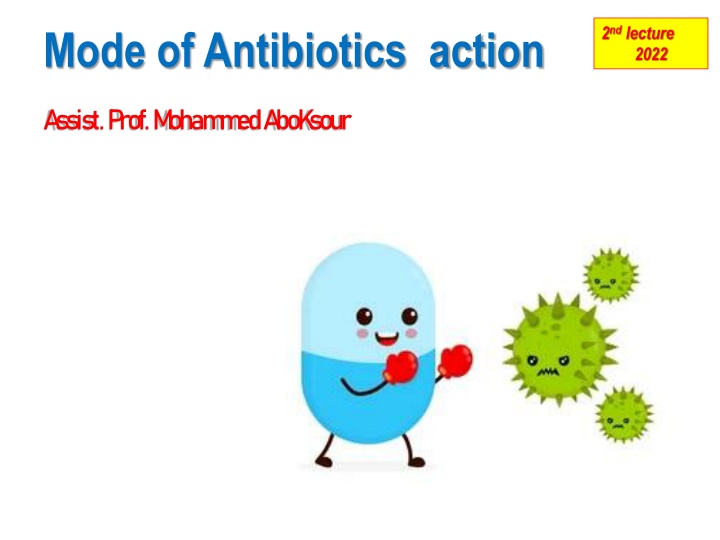
Antibacterial Agents: Mechanisms of Action and Examples
Explore the five main mechanisms of action of antibacterial agents, including inhibition of cell wall synthesis, protein synthesis, and nucleic acid synthesis. Discover how antibiotics like penicillins, cephalosporins, and vancomycin target specific bacterial components to disrupt cell function. Learn about the importance of maintaining cell membrane integrity and the role of antibiotics like polymyxin B and colistin in inhibiting cell membrane function. Gain insights into the diverse actions of antibacterial agents and their applications in treating infections.
Download Presentation

Please find below an Image/Link to download the presentation.
The content on the website is provided AS IS for your information and personal use only. It may not be sold, licensed, or shared on other websites without obtaining consent from the author. If you encounter any issues during the download, it is possible that the publisher has removed the file from their server.
You are allowed to download the files provided on this website for personal or commercial use, subject to the condition that they are used lawfully. All files are the property of their respective owners.
The content on the website is provided AS IS for your information and personal use only. It may not be sold, licensed, or shared on other websites without obtaining consent from the author.
E N D
Presentation Transcript
Mode of Antibiotics action 2nd lecture 2022 A ssist. P rof. M oham m ed A boK sour
Mechanisms of antibacterial action There are five main mechanisms by which antibacterial agents act. 1. Inhibition of cell wall synthesis 2. Inhibition to the cell membrane 3. Inhibition of protein synthesis 4. Interference with metabolism process 5. Inhibition the synthesis of nucleic acids (DNA & RNA)
1. Inhibition of cell wall synthesis (Bactericidal agents) Bacterial cell wall consist from a protective peptidoglycan layer which is a polymer of N- acetylmuramic acid (NAM) & N- acetylglucosamine (NAG). There are two important enzymes working in this place Autolysine: which break the cross link of peptides Transpeptidase: Also called penicillin binding proteins (PBPs) cross link the peptides (opposite action ).
Penicillins and cephalosporins, as well as other beta-lactam antibiotics act by inhibiting transpeptidase enzyme, thus the bacteria will loss the integrity of bacterial cell wall, leakage of its cellular component and destruction of the bacterial cell. These antibiotics attact the D-alanyl-D-alanine groups (D-Ala-D- Ala) which found at the terminus of the pentapeptide in most newly synthesized peptidoglycan monomers. Binding of the drug to the Transpeptidase (BPB) ties up the enzyme and prevents it from reforming the peptide cross-links between the rows and layers of new peptidoglycan monomers are added during bacterial cell growth
Vancomycin are stopped peptidoglycan elongation, and they effective against many gram-positive bacteria; used for resistant infections of S. aureus. Cycloserine antibiotic inhibits the formation of the basic peptidoglycan subunits. Bacitracin antibiotic disrupts the bacterial cell wall and is effective against gram-positive bacteria Used topically (skin, mucous membranes, eyes) and as a feed additive toxic to kidneys
2. Inhibition of Cell Membrane. Cell membrane is important barrier that regulate the intra- and extracellular flow of substances. A disruption or damage to this structure could result in leakage of important solutes essential for the cell s survival. Polymixin B and colistin are antibiotics posses the ability to inhibit the cell membrane, and they used as an ointment or wet dressing and often they combined with neomycin and bacitracin (triple ABX ointment). Because of high similarity of the cell membrane structure in both eukaryotic and prokaryotic cells, the action of this class of antibiotic are often poorly selective and can be toxic for the human host, and most clinical usage is topical applications.
3. Inhibition of Protein synthesis. Protein synthesis is an essential process necessary for the multiplication and survival of all bacterial cells since all enzymes and most cellular structures are made of proteins. Several types of antibacterial agents target bacterial protein synthesis by binding to either the 30s subunit or 50s subunit of the ribosomes. This will cause disruption the normal bacterial cellular metabolism, and leads to the death of the organism or the inhibition of its growth and multiplication. So the process either will be bactericidal or bacteriostatic
Aminoglycosides They are a specialized antibiotics group interfere with protein synthesis with a broad spectrum of activity, used for gram- negative bacteria. ex: gentamicin, neomycin, amikacin, tobramycin, and streptomycin. The mechanism of aminoglycosides actions are: 1. Bounding to the prokaryotic ribosome at the 16S rRNA site located in 30S subunit of the ribosome. 2. After that, aminoglycosides will bind with the A site for tRNA inhibits the translation process by causing hindering the translocation step. 3. Attachment at the A site will lead to block transition during the peptide bond forming translocation and stop elongation of the protein chain
Tetracyclines They are bacteriostatic antibiotics with a broad spectrum of activity, including rickettsial agents ex: chlortetracycline, doxycycline, and minocycline. tetracycline, oxytetracycline, Tetracyclins inhibit protein synthesis at this ribosomal level due to disruption of interactions between tRNA and mRNA in which binding of tRNA to the ribosomal acceptor site is prevented. Chloramphenicol Is a broad-spectrum bacteriostatic antibiotic that penetrates tissues and fluids well (including the eyes and CNS :central nerves system) Binds peptidyl transferase component of 50S ribosome, blocking peptide elongation. Clindamycin Narrow spectrum antibiotic, binds with 50S ribosome and blocks peptide elongation by inhibits peptidyl transferase by interfering with binding of amino acid-acyl-tRNA complex.
Macrolides Theses antibiotics reversibly bind to 50s subunit ribosome and block peptide elongation. Ex: erythromycin, azithromycin. clarithromycin, and Macrolides block assembly of 50S subunits by one of two mechanisms: By prevent polypeptide translation and causing premature release of .peptidyl tRNA intermediates. Or by interaction with the 23S rRNA. Nitrofurans Broad-spectrum antimicrobial agents that used to treat wounds (topically) and urinary tract infections. Include: furazolidone, nitrofurazone, and nitrofurantoin. Nitrofurans have specific interactions with ribosome sites such of the 30S subunit, by disrupts codon anticodon interactions and prevents mRNA translation.
4. Interference with metabolism process. Sulfonamides are broad spectrum bacteriostatic antibiotics that inhibit the synthesis of folic acid which is needed for the growth of many bacteria. Some of sulfonamides are designed to stay in the GI tract (enteric forms), and some are absorbed by the GI tract and penetrate tissues (systemic forms). Ex: sulfadiazine/trimethoprim , sulfadimethoxine, PABA Hint Bactericidal when potentiated with trimethoprim.
5. Inhibition the synthesis of nucleic acids. Fluoroquinolones are antimicrobial agents with fluorine bound to the quinolone base, which increases the effects of drug, spectrum of activity, and absorption. They are broad-spectrum antibiotics. Ex: ciprofloxacin, orbifloxacin, difloxacin, sarafloxacin. marbofloxacin, and Quinolones are types of antibiotics act in Inhibit DNA gyrases required for supercoiling of DNA. Rifamycins Is broad-spectrum antibiotics, disrupts RNA synthesis and used in conjunction with other antibiotics (usually erythromycin). Rifampin, like other rifamycins, acts by binding to the subunit of the RNA polymerase and blocks the extension of the nascent RNA chain after the first or second condensation step.
Antiparastic agents Nitroimiazoles have antibacterial and antiprotozoal activity; work by disrupting DNA and nucleic acid synthesis. An example is metronidazole, which is considered by some the drug of choice for canine diarrhea Metronidazole is used to treat Giardia andTrichomonas, as well as amoebiasis and anaerobic bacteria, this antibiotic can be taken by intravascular (IV) or oral.
Antifungal agents Antifungals: are chemicals used to treat diseases caused by fungi (mold or yeast). Some fungal diseases are superficial and others are systemic. Types of antifungals Nystatin and Amphotericin B: They work by binding to the fungal cell membrane. Ketoconazole: They work by causing leakage of the fungal cell membrane. Flucytosine: They work by interfering with the metabolism of RNA and proteins. Griseofulvin: They work by disrupting fungal cell division.
Antiviral agents Viruses are intracellular invaders that alter the host cell s metabolic pathways. Antiviral drugs act by preventing viral penetration of the host cell or by inhibiting the virus s production of RNA or DNA , like: Acyclovir : interferes with the virus s synthesis of DNA used to treat herpes virus infections (Tablets, suspension, injectable Interferons protect host cells from a number of different viruses


















